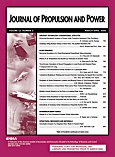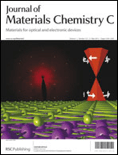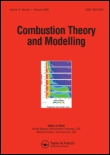
International Journal of Energetic Materials and Chemical Propulsion
Scope & Guideline
Connecting Researchers to Propel the Science of Energetic Materials.
Introduction
Aims and Scopes
- Energetic Materials Research:
The journal publishes research on the synthesis, characterization, and application of energetic materials, such as explosives and propellants, focusing on their performance, safety, and environmental impact. - Chemical Propulsion Technologies:
A core focus on various propulsion systems, including solid, liquid, and hybrid rocket motors, investigating their design, efficiency, and operational parameters. - Advanced Material Development:
Research on the development of new materials, including composites and nanomaterials, aimed at improving the performance and safety of propulsion systems. - Numerical and Experimental Investigations:
A blend of theoretical modeling and experimental studies, offering insights into combustion processes, thermal behaviors, and the dynamics of energetic materials. - Safety and Stability Assessments:
Emphasis on the safety characteristics and stability of energetic materials, including studies on ignition, decomposition, and hazard assessments.
Trending and Emerging
- Green Propulsion Technologies:
There is a growing trend towards the development and analysis of environmentally friendly propellants, such as those based on water or ionic liquids, driven by the need for sustainable aerospace solutions. - Nanotechnology in Energetic Materials:
Increased research on nanomaterials and their applications within energetic systems showcases the potential for enhanced performance and safety in propulsion systems. - Machine Learning and Automation in Testing:
The integration of machine learning and automation into testing and fault detection for rocket engines indicates a significant trend towards modernization and efficiency in propulsion system evaluations. - Hybrid and Advanced Propulsion Systems:
Emerging interest in hybrid propulsion systems and innovative designs, such as helical-port fuel grains, reflects a shift towards optimizing thrust and performance in modern aerospace applications. - Thermal and Combustion Dynamics:
Recent studies increasingly focus on the thermal characteristics and combustion behaviors of various propellants, highlighting the importance of understanding these processes for improved safety and efficiency.
Declining or Waning
- Traditional Explosives Research:
Research focused on conventional explosives and their applications has decreased, possibly due to the rise of green propellants and alternative materials that present lower environmental risks. - Basic Theoretical Studies:
There has been a waning interest in purely theoretical models without practical applications, as the field shifts towards more applied research that emphasizes real-world testing and validation. - Historical Reviews and Surveys:
While historical research provides valuable context, fewer papers focus on retrospective surveys of past propulsion projects, indicating a shift towards forward-looking research and development.
Similar Journals

JOURNAL OF PROPULSION AND POWER
Fueling Progress in Aerospace EngineeringJOURNAL OF PROPULSION AND POWER, published by the American Institute of Aeronautics and Astronautics, is a premier peer-reviewed journal dedicated to the advancement of knowledge in the fields of aerospace engineering, mechanical engineering, and fuel technology. With an impressive impact factor and ranked in the Q1 and Q2 categories for various relevant fields, the journal serves as a vital resource for researchers, professionals, and students alike who are looking to stay abreast of the latest innovations and breakthroughs in propulsion systems and power generation methodologies. Established in 1985, the journal covers a wide range of topics, ensuring a comprehensive understanding of propulsion technologies from atmospheric to space applications. Its robust Scopus rankings highlight its significance in the academic community, establishing it as a leading forum for sharing pivotal research findings and fostering collaborative dialogues that drive the aerospace industry forward. Located in Reston, Virginia, the journal does not currently offer open access options, yet it remains accessible to a vast audience via academic institutions and libraries. As we move further into the 21st century, the JOURNAL OF PROPULSION AND POWER continues to be an indispensable tool for the exploration and evolution of propulsion and power systems.

Journal of Energetic Materials
Fueling the Future of Energetic ScienceThe Journal of Energetic Materials, published by Taylor & Francis Inc, is a prominent academic journal dedicated to the field of energetic materials, encompassing topics such as explosives, propellants, and pyrotechnics. Established in 1983 and operating through 2024, this journal significantly contributes to the advancement of knowledge and expertise in the highly specialized area of energetic materials. With an impact factor that reflects its importance, it ranks in the second quartile (Q2) in the category of Physics and Astronomy (miscellaneous) for 2023, holding a strong place at 15 out of 81 in Scopus rankings, placing it in the 82nd percentile. This journal serves as a critical platform for researchers, professionals, and students, fostering rigorous research and scholarly discourse. It provides a curated collection of peer-reviewed articles, reviews, and research studies that are vital to understanding and innovating in the field of energetic materials. This accessibility supports a wide range of audiences, from academic researchers to industry professionals, aiming to explore the intricate dynamics and applications of energetic substances.

INTERNATIONAL POLYMER PROCESSING
Fostering Collaboration in Chemical and Materials SciencesINTERNATIONAL POLYMER PROCESSING, published by WALTER DE GRUYTER GMBH, serves as a crucial platform for professionals and researchers in the fields of Chemical Engineering, Industrial and Manufacturing Engineering, and Materials Science, particularly focusing on polymers and plastics. With its ISSN 0930-777X and E-ISSN 2195-8602, this journal has been in circulation since 1988 and continues to expand its contributions to contemporary research trends through to 2024. Ranking in the third quartile across multiple categories, including Chemical Engineering (miscellaneous) and Materials Chemistry, it offers insightful and rigorous peer-reviewed articles that enhance the understanding of polymer processing technologies and innovations. This journal is vital for anyone engaged in polymer science and engineering, providing both theoretical and practical perspectives that advance the field. Although it does not provide open access, the journal's content is indispensable for academia and industry professionals looking to stay at the forefront of polymer research.

Journal of the Korean Society for Aeronautical and Space Sciences
Elevating Knowledge in Aeronautical and Space SciencesThe Journal of the Korean Society for Aeronautical and Space Sciences is a dedicated platform for the dissemination of cutting-edge research in the fields of aerospace engineering and space sciences. Published by the esteemed Korean Society for Aeronautical & Space Sciences, this journal aims to bring together innovative findings and technological advancements from around the globe, thereby contributing to the ongoing development of the aerospace sector. Operating from South Korea, the journal holds an ISSN of 1225-1348 and an E-ISSN of 2287-6871, catering to both print and digital scholarly communication. Although categorized in Q4 within the Aerospace Engineering segment and ranked 139 out of 153 on Scopus, the journal plays a crucial role in fostering research collaboration and knowledge exchange among professionals, researchers, and students alike. With converged years from 2019 to 2024, it continuously seeks to enhance its contributions to the academic community through rigorous peer review and publication of original research. Given the evolution of aerospace technologies, this journal is vital for anyone involved in aeronautical research, ensuring that their work reaches the right audience.

Journal of Materials Chemistry C
Advancing the Frontiers of Material InnovationJournal of Materials Chemistry C, published by the renowned Royal Society of Chemistry, is a leading academic journal focusing on innovative research in the field of materials chemistry. With an impressive impact factor, this journal has solidified its status as a top-tier publication within its field, ranking in the Q1 category for both Chemistry (miscellaneous) and Materials Chemistry as of 2023. Positioned at the forefront of -materials science, it serves as a vital platform for researchers, professionals, and students to disseminate findings that highlight the synthesis, characterization, and application of advanced materials. The journal's open access model allows for broader readership and engagement, ensuring that groundbreaking research is accessible to a global audience. As a result, the Journal of Materials Chemistry C plays a crucial role in advancing the understanding and technology of materials, fostering collaboration and innovation within this dynamic scientific community.

Defence Technology
Shaping the Future of Engineering SolutionsDefence Technology, an esteemed journal published by KEAI PUBLISHING LTD, stands at the forefront of innovation and research in the fields of ceramics, composites, computational mechanics, mechanical engineering, and metals and alloys. Since its inception in 2013, this Open Access journal has committed itself to disseminating high-quality research, boasting a remarkable Q1 ranking across multiple categories in 2023. With a profound impact in the engineering and materials science communities, it ranks impressively within its Scopus categories—6th in Computational Mechanics and 21st in Metals and Alloys, to name a few—placing it in the top percentiles of performance. The journal's accessibility fosters a global dialogue among researchers, professionals, and students striving to push the boundaries of defence technology and material sciences. By contributing to this journal, authors join a distinguished community aimed at addressing contemporary challenges and pioneering advancements in defence applications.

PROCEEDINGS OF THE INSTITUTION OF MECHANICAL ENGINEERS PART G-JOURNAL OF AEROSPACE ENGINEERING
Advancing Aerospace Innovation Through ResearchPROCEEDINGS OF THE INSTITUTION OF MECHANICAL ENGINEERS PART G-JOURNAL OF AEROSPACE ENGINEERING, published by SAGE PUBLICATIONS LTD, stands as a pivotal resource for those immersed in the disciplines of aerospace and mechanical engineering. With an ISSN of 0954-4100 and E-ISSN of 2041-3025, this journal not only contributes to the academic community but also reflects a robust commitment to advancing knowledge within these fields. Operating from the United Kingdom, it has garnered a respectable reputation, evidenced by its category quartiles—ranking Q3 in both Aerospace Engineering and Mechanical Engineering as of 2023. Established in 1989, the journal has evolved substantially over the years, serving as a platform for groundbreaking research and innovative methodologies. Researchers, professionals, and students alike will find a wealth of insights that foster collaboration and advance the frontiers of engineering. Although currently not available as an Open Access publication, the journal remains a critical reference point for those looking to deepen their understanding and contribute to ongoing developments in aerospace technology.

Chinese Journal of Aeronautics
Fostering excellence in aerospace and mechanical engineering.Chinese Journal of Aeronautics, published by Elsevier Science Inc, serves as a premier platform for cutting-edge research in the field of aerospace and mechanical engineering. With an impressive impact factor that reflects its significant contribution to the discipline, this Open Access journal has been disseminated globally since 2002, allowing unrestricted access to high-quality articles and research findings. The journal is recognized for its exceptional ranking, holding a prestigious Q1 category in both Aerospace Engineering (Rank #8/153, 95th percentile) and Mechanical Engineering (Rank #46/672, 93rd percentile) as of 2023. It publishes original research, reviews, and technical notes that enhance our understanding of aeronautics and its applications, making it an essential resource for researchers, professionals, and students alike. Located in New York, USA, the journal continues to foster innovation and collaboration in aeronautical sciences, shaping the future of aviation and space exploration.

COMBUSTION THEORY AND MODELLING
Advancing the Frontiers of Combustion ScienceCombustion Theory and Modelling is a pivotal journal for researchers and professionals in the fields of chemical engineering, energy technology, and combustion science. Published by Taylor & Francis Ltd, this journal, with an ISSN of 1364-7830 and E-ISSN 1741-3559, provides a platform for disseminating significant advances in our understanding of combustion processes and their applications. With a solid impact factor, as reflected in its Q2 ranking across multiple categories including Chemical Engineering, Energy Engineering, and Modeling and Simulation, it serves not only to enhance theoretical knowledge but also to bridge the gap between theory and practical applications. The journal spans a wide timeline from 1997 to 2024, ensuring that it covers both foundational studies and cutting-edge research. Situated in the UK, the journal actively invites submissions that contribute to the evolving landscape of combustion science, making it an essential resource for academics, industry professionals, and students keen on exploring the dynamics of energy and fuel technologies.

INDIAN JOURNAL OF ENGINEERING AND MATERIALS SCIENCES
Advancing the Frontiers of Engineering and Materials ScienceThe Indian Journal of Engineering and Materials Sciences is a pivotal publication within the engineering and materials science realms, focusing on fostering innovative research and knowledge dissemination in these dynamic fields. Published by the renowned National Institute of Science Communication (NISCAIR), this journal plays a critical role in bridging the gap between academic research and practical application. With its impact reflected in a Q2 ranking in Engineering and a Q3 ranking in Materials Science for 2023, the journal positions itself as a significant contributor to the discourse surrounding engineering advancements and material innovations. Since its inception in 1994, it has been a platform for researchers, professionals, and students, enhancing their ability to access high-quality research outputs. The journal is committed to providing open access to its valuable content, ensuring that knowledge remains universally accessible. As the field continues to evolve, the Indian Journal of Engineering and Materials Sciences remains a vital resource for those aiming to stay at the forefront of research and development.